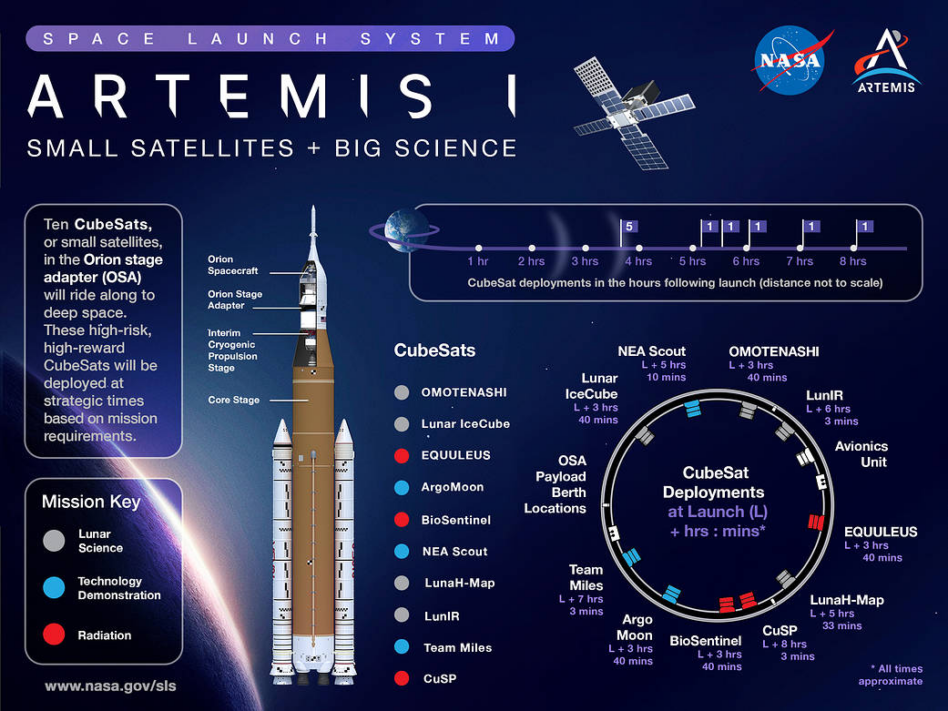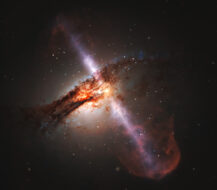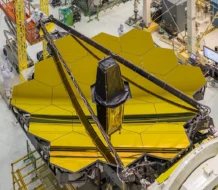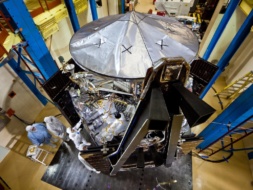It finally happened. SLS made it off the ground, and as you read this, the Orion capsule is en route to the Moon.
Though the main spectacle was certainly NASA’s $4.1B, 322-foot-tall rocket lifting off and launching Orion farther than any human-rated spacecraft has gone before, that’s not all that Artemis I had going for it. After Orion separated from the interim cryogenic propulsion stage (ICPS), the stage deployed ten shoebox-sized cubesats, each an individual science mission designed by a NASA partner.
Need a boost? The ten cubesats have been in storage for a year, and over the past few months, they’ve been unreachable, contained within the stacked rocket. That’s not great for their batteries, which have slowly lost charge over time at a rate of ~2% per month.
Four of the satellites are designed to be rechargeable while attached to the rocket, but the others are not designed to charge until their solar arrays catch sunlight in space. If the batteries in these satellites lack the charge to meet their minimum mission requirements, then they won’t be able to begin their missions until the solar panels charge them up enough.
Not to worry, though—while it’s possible that some of the cubesats will have to wait longer than hoped before beginning observations, the battery issue is unlikely to be a mission-killer.
The rundown
Each of the ten cubesat missions is either studying some aspect of the Moon, demonstrating new technology, or measuring radiation in space.
Lunar science: In keeping with the whole theme of Artemis I, four of the ten cubesats will pursue missions studying the Moon.
- OMOTENASHI is the only member of the group that will actually land on the Moon’s surface. The JAXA-developed probe will test the propulsion, communication, and power systems needed to land a small craft on another celestial body.
- Lunar IceCube is equipped with a spectrometer to study water ice on the Moon. Scientists are hoping to gather information about the absorption and release of water in the lunar regolith (i.e., the dust and rock making up the lunar surface).
- LunaH-Map is also on the lunar ice studying train. The craft, developed by Arizona State University, is creating a map of water ice on the moon using a neutron detector that can identify the presence of hydrogen.
- LunIR is taking a broader view of the Moon’s surface. It will conduct a flyby and image the surface using an infrared sensor to identify potential future landing sites, among other things.
Tech demonstrations: It’s not all Moon science. Artemis I was also an opportunity to test out some technologies that could prove useful on future missions.
- ArgoMoon won’t be traveling far from ICPS. The Italian craft will instead perform proximity operations to keep up with the stage, taking photos for mission documentation purposes.
- NEA Scout is turning its focus to deep space. The cubesat is equipped with a solar sail that it will use to chase down an asteroid ~60 feet in diameter—the smallest ever visited by a spacecraft.
- Team Miles was built by a citizen science organization, and it’s also headed out into the void. It’s planning to test some innovative plasma thrusters that would come in handy on distant voyages in space.
Radiation probes:
- EQUULEUS is the super catchy nickname for the “EQUilibriUm Lunar-Earth point 6U Spacecraft” mission. The JAXA cubesat will travel to the Earth-Moon Lagrange Point 2, where the gravitational forces of the two bodies are in balance, to measure the distribution of the plasmasphere, an environment full of highly ionized particles.
- BioSentinel is going farther than any biology experiment has gone before. Scientists will send the craft beyond the Earth’s magnetic field and into solar orbit, then trigger a series of yeast growth experiments in the harsh radiation environment of space.
- CuSP, the CubeSat to Study Solar Particles will study…drumroll, please…solar particles. The craft is equipped with three instruments that will track solar flares and radiation events before they reach Earth.
This story first appeared in Parallax, our weekly space science newsletter. Subscribe to Parallax here.




